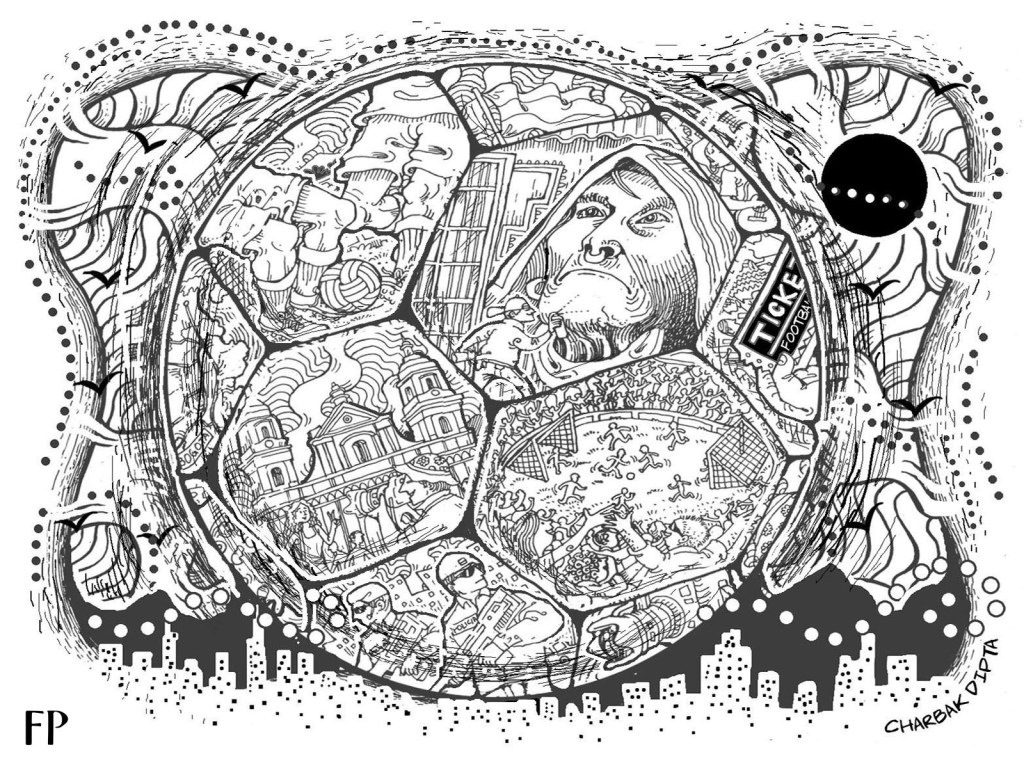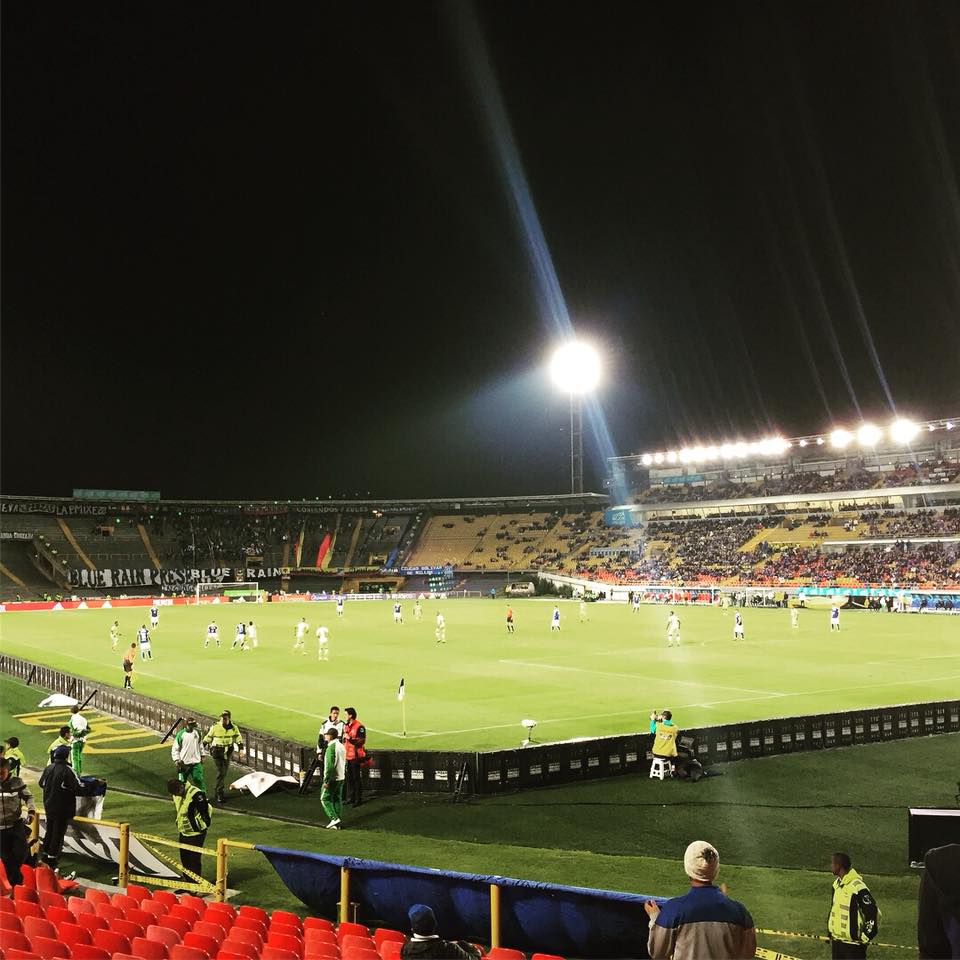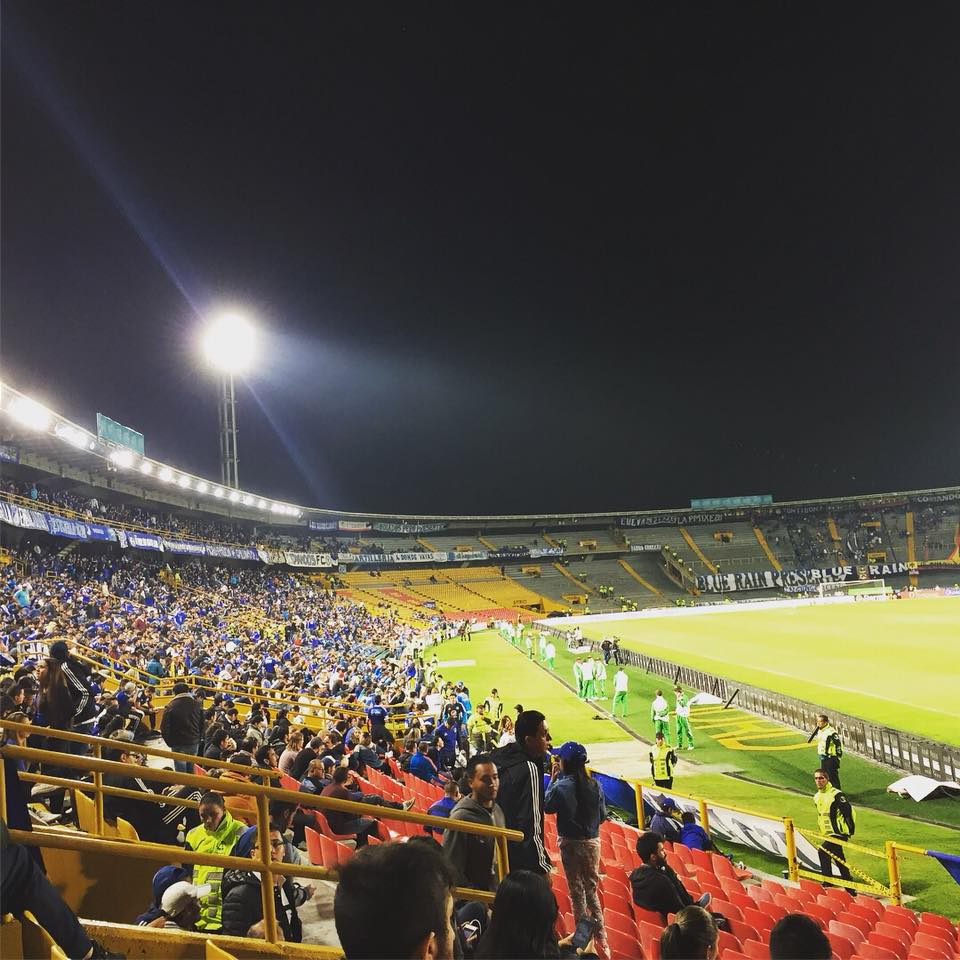Santokie Nagulendran roams through the streets of Bogota, talking race, lineage and rivalries before entering the El Campin to watch Millonarios, the biggest team from the city, play football.

It’s a cold, eerily quiet evening. The streets are barely lit, so there is a darkness to accompany the silence on the streets as I walk to Estadio El Campin from my hotel, aptly named “Hotel El Campin” due to its proximity to the venue. The hotel receptionist told me it would probably be better to get a taxi to the stadium, but part of the fun of going to games abroad is to walk with the fans, immerse yourself in the culture around the home club. However, the walk to the stadium is subdued, there aren’t too many fans around, or people in general for that matter, all I can hear is the chirping of crickets in the air. Have I got the right date? I carry on walking and then all reveals itself as I turn a dark corner, a massive grey structure covering the horizon, police sirens wail and there is a sea blue wave in the distance making loud noises. The blue of Millionarios. Football in Bogota. Let’s do this. 
Bogota is a temperamental city. In one instance the weather can go from chilly winds to blazing heat, there’s an unpredictability to the climate that adds to the allure of Colombia’s capital. Historically, Bogota has always been a transit stop for travellers in Colombia, with most choosing to spend most of their time in Medellin or Cartagena, a colonial town on the Caribbean coast of the country. However, recent years have seen Bogota blossom as an attraction itself; the stunning political graffiti that encompasses its concrete surroundings add a vibrancy to a city which already has amazing museums and a remarkably diverse food culture.

Bogota’s two major clubs are Santa Fe, who wear red, and Millionarios, who wear blue. People here wear football shirts everywhere, so a walk during the day time through Bogota is a colour fest, with people wearing red, blue and yellow (the National kit) in waves. My stay in Bogota sees Millionarios play a home game on a Sunday evening, which means by default this will be my team in Bogota. Millionarios for life.
After feasting on Empanadas and doing a Graffiti tour of the city, I decide to find out more about my new club; Millionarios haven’t won the Colombian Premier division since 1996, yet have regularly finished in the top half of the division. In Colombia, the league title is decided via a knockout round between the top 8 teams. Last season they lost in the semi-finals to eventual champions Atletico Nacional.
Buying tickets for the game proved to be the hardest of all my travels abroad: rather than have a ticket office near the stadium, the only place to buy tickets is a random shop a few roads away, down a suspicious side street. The queue itself to buy tickets also proves to be a challenge as a constant flow of people are trying to sell food, tickets, or simply beg for money, harassing everyone standing in line, fully aware of the fact they have money if they are buying tickets.
Against this backdrop, I meet Jose, who hears me speak English to my partner and promptly begins to start a conversation in the line. An army man on leave from his base, Jose explains he learnt English abroad and is happy he has found a chance to practice it with me. Bewilderment then ensued as I introduced my name and explained it was Guyanese, which of course is geographically very close to Colombia, ‘’But…but you look Indian!’’ was all Jose could muster at this seemingly improbable revelation that we shared some sort of continental link.
With not enough time to explain the history of systematic Indian indentured labour to South America, I begun to talk about the match ahead of us. Millionarios vs Jaguares de Cordoba, a team founded in 2012 who have gradually been improving season after season since their inception, finishing 5th last season. However, this was not seen as a glamorous game, but one where Millionarios were expecting a comfortable win.
Jose is a calm man but even he will not bring himself to utter the words Santa Fe, Millionarios’s city-rivals, who play in what is known as the ‘’El Clasico Capitalino’’ i.e the Capital Classic. He also explains that as seating is unreserved, it is best to buy the cheapest seats possible (around $12USD) and then work your way around to the expensive seats during the match, as they are never occupied. Thankful for this advice, I buy tickets and am surprised to see Jose waiting for us outside. Concerned about potential thieves outside the ticket shop, he walks us to the stadium gates and then bids us a farewell once we are safe inside. A random act of kindness but certainly not one forgotten.

The stadium itself is wide, with seating far away from the actual pitch. This distance from the field has seemingly no effect on fans, who all congregate in the middle stands to create some sort of atmosphere. The actual stadium is less than half full, perhaps because this game is taking place on a Sunday evening and its cold, but the fans in attendance try their best to create a sense of volatility. At no point in the middle stand does anybody take a seat on the long benches which are used instead of individual seats, people bouncing up and down, singing, waving blue flags, this despite, from what I see on the field, is actually a slow and unadventurous game, both sides making mistakes and rarely attacking the goal. Yet the fans were unwavering in their excitement.

In the end it finished 1-1, a second half strike from Millionarios had seemingly won the game before Jaguares equalised with a penalty in the 92nd minute, which was the cue for scenes of sheer rage from the fans. I actually did not see any away fans at this game, which makes sense; to travel from the city Monteria (where Jaguares are based) to Bogota, is a 75 minute plane ride or a 16 hour car drive. Upon the full-time whistle, the fans rapidly disperse from the stadium, and as we leave the entrance gates we are met with armed policemen in full riot gear patrolling, eyes wide open, waiting for something to happen. Colombian football is passionate but you also get the sense of fear at games owing to its history of violence; going to a pizza shop afterwards, the worker hastily locks the front door when he says a large group of fans approaching.
Bogota is a stunning city, truly colourful, yet football in the city does not get the same tourism as Atletico Nacional in Medellin, owing to the lack of context and notoriety of the teams, but for uniqueness and an enjoyable evening out, it is highly recommended to check out Millionarios or Santa Fe.


















